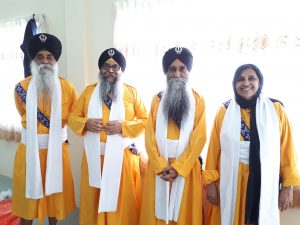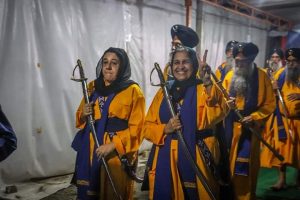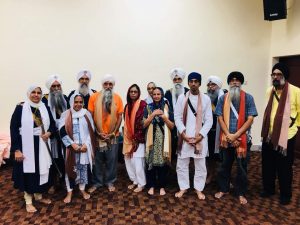



Pictures above after the Amrit Sanchar ceremony
After talking of my childhood and my first job at the Penang Bridge Project, I will now tell you something about my faith. I was born into a Sikh family and as such, try my best to be a good one. Both my parents were raised in India, so whatever they knew was either from the priests or elders in their village. This information was passed on to their children. I will explain in very simple words about who Sikhs are and what is their purpose on earth. You may have seen men with turbans and long beards, they are Sikhs.
The Sikhs have ten gurus; starting from Guru Nanak followed by Guru Angad, Guru Amardas, Guru Ramdas, Guru Arjan, Guru Har Gobind Sahib, Guru Har Krishan, Guru Hai Rai, Guru Tegh Bahadur and Guru Gobind Singh. After Guru Gobind Singh Ji, we were gifted with holy scriptures or shabads compiled into a holy book and with respect is called Sri Guru Granth Sahib Ji. The last guru ordered his Sikhs to treat this holy book as their guru, so it can be said the 11th guru is the shabad guru. The Sikhs do a prayer or ‘Ardas’ where they pour out their hearts and receive a message which is called the ‘Hukamnama’ or ‘Vaak’. The Sri Guru Granth Sahib Ji is opened and when a shabad is read from it, it conveys a message to the listeners. Sikhs do an ardas before they perform any task to get blessings from our Guruji. The Guru Granth Sahib is not only placed in the gurdwara (Sikh temples) but can be found in Sikh homes too. A good Sikh’s life is like this; He/she rises in the morning, takes a shower, does the morning prayers or Nitnem and only then consumes his/her breakfast. The Nitnem or 5 morning prayers (or banees) are Jup, Jaap, Tavprasad Sevaiyay, Chaupayee and Anand Sahib. The evening prayer is Rehraas and before sleeping a Sikh does Sohela. He thanks God for blessing him with a beautiful day.
When Sikhs visit a gurdwara in the morning they will be able to listen to one more prayer which is Asa Ki Vaar which is sung in raga. Sri Guru Granth Sahib Ji has 1430 pages and during “Akhand Path” all these pages are read in 48 hours. Akhand Path means non-stop reciting of the Sri Guru Granth Sahib Ji for 48 hours and after that the Ardas is done.
In Sikh religion, when a child is born in the family, the father of the newborn or a family member goes to the gurdwara to do an ardas. When the granthi or priest reads the vaak or hukamnama, the alphabet from the first shabad he reads is used for the baby’s name. Today, some people just name their child after a well known celebrity or picks a name from the internet. Once the new mother is ready, she carries the new born to the gurdwara where the priest does an initiation ceremony or Janam Sanskar to bring the child into Sikhi. The granthi reads the Jup banee while stirring cube sugar in an iron bowl and 5 drops are put into the child’s mouth. The mother is given this amrit too, a sign of purification. Similarly, we have an initiation ceremony or ‘Amrit’ for an adult or any person who wishes to become a true Sikh. There are 5 ‘K’s or compulsory accessories required by a Sikh. These are kays (uncut hair), kanga (wooden comb), kirpan (ceremonial dagger), kedha (steel bangle) and keshaira (drawers). The Amrit Sanchar team initiating the ceremony has 5 Sikhs or the Punj Pyareys and 2 or 3 helpers. These Sikhs must first be initiated and follow the rules strictly. The 4 kurehats (prohibitions) are : 1) No cutting of hair 2) No intoxication 3) No halal meat or sacrificed meat 4) No adultery.
The Sikhs who form the 5 pyareys have to abide by the rules set in the Sikh Rehat Maryada (Sikh Ethics and Conduct of Life) and give daswand (1 tenth of their earnings for God’s work which can be to help the needy). They should also be honest earners and do lots of ‘sewa” (community service). When it is required of them, they should be ready to serve. This was how the Punj Pyareys were formed by the tenth Guru on Vasakhi day in 1699. At that time, when Guru Gobind Singh Ji requested, 5 men rose and offered to sacrifice their heads. Up till today, their names are read in every Ardas. Bhai Daya Singh Ji, Bhai Dharam Singh Ji, Bhai Mohkam Singh Ji, Bhai Himmat Singh Ji and Bhai Sahib Singh Ji. Today, the Punj Pyareys are called upon to lay a brick for a new gurdwara or a new building. They also give their service at the Amrit Sanchar ceremony.
Now I will tell you more of my Sikhi upbringing. After studying Punjabi with my Giani ji, Joga Singh for some years, I stopped for a bit and continued with my studies. When I was about 18 years, the interest in me to learn kirtan with the use of harmonium arose in me. I kept pestering my Ma to buy me a ‘waja’ (harmonium). Back in those days, it was about RM200 and that was considered to be a lot of money. Of course, I was not going to ask my Papa for this kind of money. You know, Ma used to sew blouses and she had saved up a bit. So finally, one day we bought a ‘waja’ from one trader bhai who came to our gurdwara to sell his merchandise. I was so happy, as though I had won the lottery but I was only the owner of this waja or harmonium and I brought it home on my bicycle. I was scared of Papa and hid it under the bed and only practiced when he was not around. I went to the priest who taught me from ‘Sa re ga ma pa dha ni sa” (Do re mi fa so la ti do) and I started singing shabads from the Guru Granth Sahib Ji. Ma would come back from the gurdwara and relate to me the tune of some shabad and I took out the tune on my waja and sang it. This brought me great joy, it was coming from my heart and I started singing in the gurdwara. I found friends who shared this interest with me; Tirlochan Singh, Gurjit Kaur, Jasbir Kaur, Satnam Kaur and Kashmir Kaur and then one day I found Savendar Kaur. Our voices matched and we made a great team. We sang at every gurdwara function and were famous back then. Unfortunately, we had to split when I moved to Kuala Lumpur, it was my destiny.
Something else happened at that time. The youth group called the Naujawan Satsang was established in Wadda Gurdwara Penang by late Sardar Kabal Singh and Karminder Singh. Kabal Singh was a lecturer at the Teachers’ Training College in Gelugor and Karminder Singh was a student at Universiti Sains Malaysia. I give my highest respect to the late Kabal Singh who coached me and wrote various speeches so I could announce at the podium during the youth meetup. His knowledge of Punjabi was excellent and I will be remember this till I die. Karminder Singh, went on for further studies abroad much later on, is now a Phd holder. He has written a number of books not only on Sikhi but in other fields too.
Back to my story—Penang Naujawan Satsang had members from Penang as well as Butterworth. After some time, the Butterworth youth broke up and formed the Butterworth Naujawan Satsang/Butterworth Sewaks. There were many spots vacant in the Penang branch now, so I was elected to be the Secretary to the Penang Satsang (Satsang means prayer group) and Dr Rabinderjeet Singh was made the president. We had other youngsters who joined us in the committee. We had fortnightly programmes in the gurdwara where the youth did kirtan, ardas and took the hukamnama from Sri Guru Granth Sahib Ji. Giani ji had taught me well, I was given the experience in the Satsang programmes and this proved to be useful in my later years. I will tell you more about the Penang State Satsang in my next article, it was really something.
About 15 years ago from now, I also went through the Amrit sanchar ceremony and started following the Sikh way of life. I went to Wadda Gurdwara Kampung Pandan and did kirtan there and what little community service I could. One fine day (about 10 years ago) I was at the Ampang temple and one Sikh gentleman (he was in the Amrit Sanchar team) approached me. He had listened to my kirtan (singing of hymns) and asked me if I was interested to join the Amrit Sanchar team to which I quickly declined. This was a difficult task and I was not sure I could handle it. He assured me that it was only giving a lending hand to the Punj Pyarey. After a bit of persuasion, I agreed. I was to go to the Samelan (Annual Sikh Camp) in Rembau the next day. I went and helped and only then did I know how the Punj Pyarey’s team worked. Each pyara or member of this team had to memorize all the Nitnem banees as each one was required to recite one of the banees while stirring the Amrit. Now I will tell you how the Amrit is made. In a large iron bowl, water is poured in, then sugar cubes and with an iron kirpan (the ceremonial dagger), the water is stirred while the banees are read, one at a time. The start of the Amrit is with an Ardas, hukamnama is read and a total of 4 Ardas is done for the whole ceremony. The Amrit is then distributed, squatting on one leg (veerasan) on the floor, one at a time to the Amrit ablakhee (the person taking the Amrit) and the remainder of the Amrit in the bowl is distributed to everyone till every drop of the nectar is finished. After that, a short Anand Sahib (5 paudis) prayer is done and Ardas. After the hukamnama, degh is served first to the Punj Pyarey, the priest and a big amount is given to the abhlakhees. They have to eat from the same bowl, a sign of equality without any caste or class. Here, once Amrit has been given to a Sikh, he enters the Khalsa brotherhood. When a Sikh greets another Khalsa Sikh, he utters ‘Waheguru Ji Ka Khalsa, Waheguru Ji Ki Fateh and gets a same response. It means the Almighty owns the Khalsa and Victory is to the Almighty.
The Amrit Sanchar team consists of all men, ladies just help out becoming ‘pehreydhar’ (guards) and ‘Granthi’ (priest). The guards stand at the door to keep away people from budging in the prayer hall as this is a sacred ceremony. The priest recites the hukamnama once an Ardas is done, so he is an important person. Once the final hukamnama is read, the “guards” come in and distribute the degh. Degh is made with Atta flour, sugar and ghee. The ghee and Atta is fried till light brown, water is boiled with the sugar and added in, so it becomes a pudding. While preparing Degh in the gurdwara, Jup banee is read simultaneously by the priest.

I had been serving in this team for a number of years, being granthi or pehreydhar without looking back. Then one day, I asked the chief why was a woman not allowed to participate as a pyara. He dismissed my query saying that I had not memorized all the banees. The next time, he called upon a young boy who was made a pyara and that young fellow did not know all the banees. This was gender discrimination and it was happening in front of my eyes. Another pyara pointed out but the Chief was adamant, he just did not want a female close to him. The pyaras sit next to one another in a semi circle before the Guru Granth Sahib. I did not give up, I asked him everytime we had the ceremony and he let me participate on one occasion when there were not enough Sikhs to make the Punj pyrayes. I was happy, I read the Chaupaii prayer as we sat with both our hands on the iron bowl. The feeling cannot be described….. A kind of power spreads through the body while each of us is reciting with our eyes focused on the water and the surrounding is serene.

Another picture of an amrit sanchar ceremony – Sikh men and women after taking the amrit
Lucky me, I was again given a chance by Guruji to be the Punj pyara and I felt honoured and quickly grabbed it. Why is it important for a woman in Malaysia to be given such a status side by side to a man? One elderly lady came up to me and asked me, “How come you are a Punj Pyara”? My answer to her was, “Why not? If I have female students in my class who want to be pilots and astronauts, why cannot women be Punj Pyareys?” Fellow women should assist to raise other women, not put them down.

Picture taken from Asia Samachar (online media) – with thanks
I feel I was chosen to inspire girls and women in Malaysia that if we put our mind on something, we are able to achieve it. In my case, the bhai saabs helped me and were there for me at every step of the journey. The open mindedness of these men paved a way for women in the ‘all-men’ team. Today, we have more women in our team and I am so grateful to Guruji. We cannot change the mindset of the people in India, but we can in Malaysia.
Moving forward, it would be nice to have an ‘all-women’ team. Sikhism is liberal, it does not see a woman as impure when she is menstruating as stated by Guru Nanak in Asa Ki Vaar banee (So kio manda akhiya, jit jammey rajan – why do you look down on a woman, she gives birth to kings). Sikh women can pray, read banee and are free to do kirtan on their ‘monthly’ days, just have to be clean inwardly.

Giving utmost respect to Sri Guru Granth Sahib Ji by placing high on the head
My advice to all is — The first step for all girls and women out there is; please educate your girls beginning with yourself. Begin with Punjabi language, then go on to other foreign languages. Learn to read the scriptures (banee) and understand it (read the meanings) so nobody can fool you. When you are equipped with ‘gian’ (knowledge) the journey will be smooth. While having a successful career in this material world, be at the top in the spiritual world too.
Next, we do not want to judge others. It is their life and they can live it according to how they want it to be. If you want to follow our Guruji’s way, then the first step is taking Amrit. Read and understand the banee and live your life according to it. If someone is unfair and unjust to you, be courageous and stand up for your rights, then forgive and move on. By taking Amrit, it will be baby steps you take, slowly while you are reading, understanding and contemplating the banee, you will find contentment and peace or some call it ‘bliss’. Keep helping others quietly. You do not need to show proof as the Almighty can see everything. Sikhism does not force anyone to become a Sikh, it is the love that brings a Sikh to his/her Guru. Guru Nanak writes in Sri Guru Granth Sahib Ji (page 1412), “Joh toh prem khelan ka chao, seer dhar teli geli meri aao” which means, if you desire to play the game of love, come with your head on the palm of your hand. He goes on to say that once you set foot on this path, you sacrifice your head without bothering of others’ opinion of you.
As far as possible, we need to empower women to come out of their shells to dream of what they can achieve in life. If they need help, they can approach someone in their community who is kind enough to hear them out. I want to help every girl and every woman but there is only that much I can do. Our purpose is; our balance sheet should be favourable with collection of good values to take along on that solo journey which everyone has to make some day.
After retirement, my mission now is to teach Punjabi full time and Banee to any interested person. My time is getting shorter and I hope to accomplish as much as possible before I pack up to leave.


